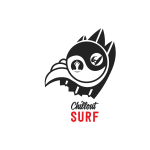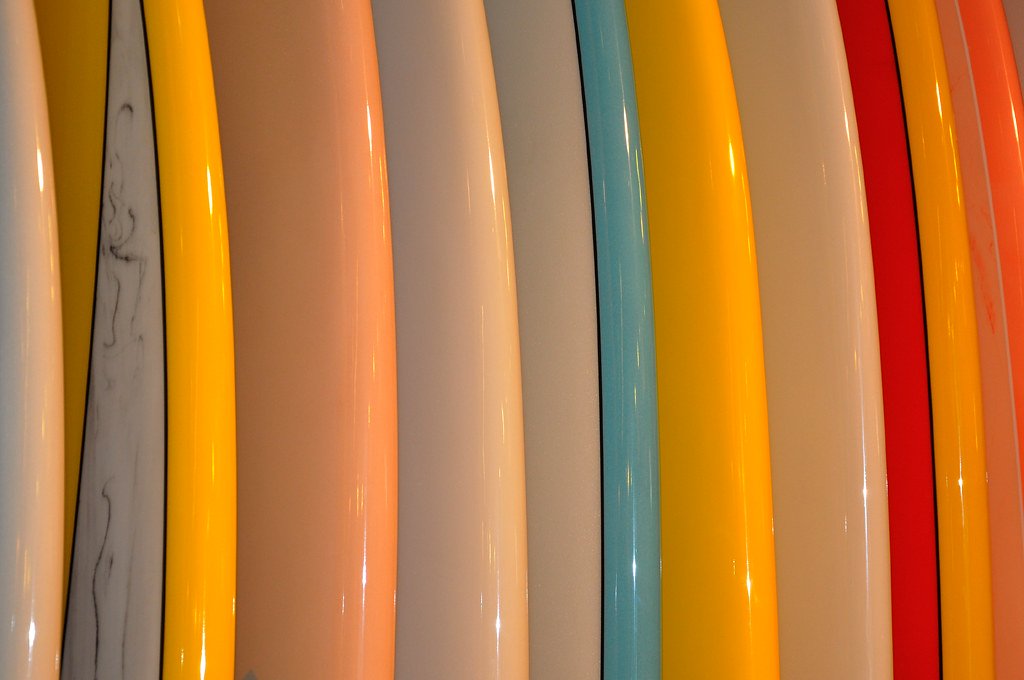Surfing Dictionary – Surfing Terms and Definitions
These are the Surfing Terms, Definitions, Slang and other words currently stored in our Surfing Dictionary. If you know any surfing terms that are not mentioned in this list then go ahead and suggest a word for our dictionary.
There are 81 Surfing Terms in our Surfing Dictionary:
- AXED
This term refers to a surfer when hit by the lip of the wave which leads to a wipeout. - BACKHAND
This means to surf with your back to the wave. - BACKSIDE
When riding a wave, facing the beach with your back to the wave. - BANK
The bank is the sandbank on which waves break. - BARREL
The “tube” of the wave, the ultimate ride in surfing, to enter the wave itself as it breaks over you, and successfully exiting. - BEACH BREAK
Beach Break refers to the surf breaking on a sandy beach. - BLADE
Another word for your surfboard. - BLANK
A blank is a block of foam from which a custom surfboard is made. - BLOWN OUT
This is the term used to refer to choppy surf resulting from onshore winds. - BODYBOARDING
Bodyboarding is surfing while lying down on a bodyboard instead of standing up on a surfboard. - BODYSURFING
Bodysurfing is surfing without the benefit of anything except one’s own body, with only the use of fins. - BOMBORA
A bombora is a deep water, offshore reef break. - BONEYARD
The impact zone, the place you don’t want to be when the sneaker set comes! - BOTTOM TURN
This refers to a turn at the bottom of the wave face. - BREAK
A place where the surf is exceptionally good. It usually consists of a “peak” or long “peeling” lines of waves. - CHANNEL
A channel refers to a deep water gap between sandbanks or reefs. - CHOPPY
Choppy refers to the ocean under an onshore wind. - CLEAN
Clean refers to glassy, peeling waves and/or good surf conditions. - CLEAN-UP
A clean-up is when a large set catches everybody inside. - CLOSE-OUT
A close-out is a wave that breaks along its entire length simultaneously. - CUTBACK
This is a turn wherein you reverse your direction completely, right to left or left to right. - DECK
The deck is the upper surface of aboard. - DING
This refers to a dent or hole in the surfboard. - DOUBLE UP
This is when one wave overtakes another. - FACE
This is the smooth, unbroken portion of the wave. - FLOATER
This refers to momentarily surfing on the outer, top portion of the lip before falling down and in front of the wave while it breaks and continues your ride. - FOREHAND
This term refers to surfing with your face to the wave. - FRONTSIDE
When riding a wave, facing the wave with your back to the beach. - GLASSY
This is to surf with either light offshore wind or no wind at all. - GNARLY
This term could mean heavy, difficult waves which are usually quite big. - GREMMIE/GREMLINE
Archaic, what we used to call Groms back in the ’60s when I was a gremmie… - GROMMET
This term is used to describe a young and precocious surfer. - GUN
A gun is a big wave board which is long and narrow in shape. - HANG 10
Positioning yourself so that all your toes are draped over the nose of the board as you glide down the wave. There’s no such thing as a “cheater ten,” you can’t fake hanging ten. - HANG FIVE / CHEATER FIVE
Draping five toes over the nose of the board. A “cheater five” is where the surfer is actually placing the majority of his or her weight on the back foot, and simply sticking the forward foot out as far as it can go. - IMPACT ZONE
This the point at which a swell is breaking most heavily and most frequently. - KICK-OUT
This is done by making a controlled exit from a wave by riding up the face and over the top. - KOOK
A wannabe surfer, someone who talks about the great waves he or she catches, but no one ever sees them. A surfer of limited experience who is in the habit of constantly being in the wrong place at the wrong time, often ruining an experienced surfer’s ride. - LIFT
These are forces generated on the surfboard that holds you up. - LINED-UP
This term is used to describe an even, well-developed swell. - LINEUP
The area where surfers congregate, waiting for waves. Originally, people paddled out and waited for their turn to take a wave, hence the term. No one waits in a lineup anymore, but the term is still used. First come, first served. - LIP
The part of the wave that pitches forth from the crest. - LULL
This is a period of time wherein waves either quit coming altogether or arrive at a much-reduced size. - MUSH
These are waves that break softly or sloppily with little power. - OFF THE LIP
Maneuvering your board using the “lip” of the wave. - OFFSHORE
When the prevailing winds are blowing from the land to the sea. This usually helps the wave stand up,
making it more hollow. - OUTSIDE/OUT THE BACK
This is the area beyond the impact zone. - OVERHEAD
These are waves that exceed the height of the rider. - PEAK
This is the point at which a wave breaks first, from which it ideally peels in one or both directions. - PEEL OFF
This is a process whereby a wave breaks starting off in one particular place and then zippering along cleanly and evenly for a distance. - PET THE CAT
When trying to enter the tube, it sometimes becomes necessary for a surfer to slow down. One technique is to “Pet the Cat”. A surfer is petting the cat when he places his hand in the face of the wave, dragging it through the water. This can control the speed of the rider so that they can slow themselves into the tube, or release enough to get out of the tube. - POCKET
This is the steepest and most powerful part of the wave. - POINT BREAK
An area jutting into the sea which causes waves to break either right or left on either side of the point. - PUMPING
This term is used to describe a good, powerful swell. - RASHGUARD/RASHIE
Slick material used either under a wetsuit or by itself. Protects the skin from, obviously, rashes which can be caused by friction against the wax or the board itself. - REEF BREAK
This is a surf spot where waves encounter a distinctively contoured reef, causing them to break with distinctively good shape. - RIP
This refers to a channel of water running out to sea. - ROGUE
A wave that is decidedly larger than most of the other waves you are experiencing during a particular session. - ROGUE WAVE
An outside wave that “comes out of nowhere”. Usually larger than most of the other waves you will see in that session. - SANDBAR
This is one feature of ocean bottom which has a great effect on the shape of waves. Sandbars get moved around by larger waves, one day a peak breaks here – next day, it can be gone. Sandbars are usually found at beach breaks and river mouths. - SET
This refers to a group of waves. - SIDE BITES
These are the smaller, outside fins in a three-fin setup. - SKEG
This is the Archaic term for the surfboard fin. - SLIDE HANGER
An open-ended, wetsuit hanger designed to slide into position at the waist of the wetsuit. The wetsuit is draped over a circular I-beam bar - SLOP
This refers to lousy or weak surf. - SNEAKER SET
The set of waves that seems to come out of nowhere. This usually shows up just after everyone on the outside has gotten tired of waiting for the next outside set, and has paddled to the inside to catch a few. This is also known as the “clean up” set. - SOUP
This term refers to the white water of a broken wave. - SPIN-OUT
A Spin-out is when the fins of the board break loose from the water surface. - SPITTING A LIP
When a wave throws out the uppermost portion of the wave, creating a tube or barrel. Getting hit upside the head by a spitting lip can be painful. Exercise caution whenever a wave spits a lip. - STOKED
The state of near-Nirvana that accompanies a surf session. Has been known to cause those who are stoked to walk about with a zombie-like expression and a huge smile on their faces for days. - SUCKY
This refers to a hollow, often heavy wave. - SURF NAZI
Intolerant locals (generally, but you can find them anywhere) who feel they “own” the break and don’t want you there. They are generally cowardly, insecure types and have been known to start fights with surfers who are smaller than they are. - TAKE-OFF
A Take-off is the start of the ride. - THE GREEN ROOM
This refers to the tube or barrel of a wave. This is also known as “The Green Cathedral”. - TRIM/TRIMMING
This means riding the board at an angle to the wave, sidelong down the length of the beach, instead of aiming straight at the beach as you ride. - TUBE
Tube refers to the inside of a hollow wave. - VICTORY AT SEA
This refers to large, choppy surf. - WAHINE
A female surfer. - WAX
Surfboard wax is applied to the deck of the board to prevent slipping off while riding. - WETSUIT/WETTIE
The neoprene suit was worn by surfers during cooler times. Should fit snugly to allow just a bit of water to enter. The body heat warms the water and helps keep the surfer warmer in cool/cold water. Measured by the thickness of the neoprene ie; 4/3, 3/2, etc. The numbers designate the thickness of the neoprene. - WIPEOUT
This means to fall off, or get knocked off, your surfboard.

 English
English Deutsch
Deutsch Spanish
Spanish
0 Comments